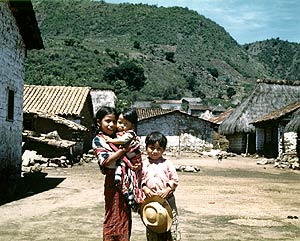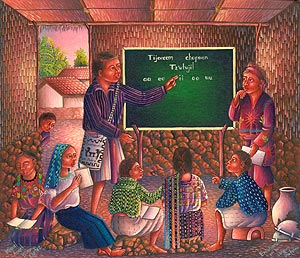
[Introduction]
In general, infants in San Pedro receive good care and escape the frustration of adjusting to fixed feeding schedules and the early demands for cleanliness characteristic of other societies. Babies are well clothed and rediapered frequently. By day they sleep in a hammock, safely and comfortably, and at night they share their mother's bed. They are offered the breast whenever they cry. If the mother is temporarily absent, an older sister or another woman of the household pacifies a child by picking it up.
Baptism is usually delayed until the child is about six months old. The reasons usually given for the delay are difficulty of paying the fee or rarity of the priest's arrival in San Pedro. Actually, parents are reluctant to expose the infant to the crowd at the baptismal font and hence to the chance of "evil-eye" before it is old enough to withstand the danger. Women school teachers temporarily stationed in San Pedro are the most common choice for godmothers, since they are not Indians and are considered more worldly in their knowledge.
Babies are introduced early to corn gruel and bits of tortilla, but they continue nursing until they are twelve or eighteen months old. The usual reason for weaning is the advanced pregnancy of the mother. The milk is believed to be injurious to the nursing child when the mother is in the fourth or fifth month of pregnancy.
As a rule the average mother gives birth to a baby every year and a half or two years. She bears from six to a dozen children. But only half (or less) of this number survive, most deaths occurring in early infancy because of infection or other disease. Birth control is not practiced, or at least not countenanced. Some couples remain childless, but these are considered unusual cases attributable either to the "strong blood" of the wife or the unhappy coincidence of "weak blood" in both partners. The concept of blood strength approximates what we might term strength of character or individual forcefulness. Fathers are said metaphorically to carry the fate of their daughters on their backs, mothers to control the destiny of their sons.
Children of crawling age are carried about in a shawl rather than left for long periods on the floor where they are in danger of upsetting pots, getting into the fire, or contracting dysentery and other illnesses from the dirt floor. They are aided in taking their first steps but are not prodded into walking. No effort is made to instruct them in toilet training until they are old enough to walk and talk. When they are two or three years old, they are encouraged to go into the yard when they feel the need. Later they learn to use an out-house. Beyond occasional shaming devices, no punishment is used to hasten toilet training.
Everything considered, children receive benign treatment during their first year or two of life, enjoying the affectionate and permissive handling now advocated by child psychologists in America. But secure infancy, by itself, is no augury of a model adult personality. Much depends on the nature and tone of subsequent experiences in and outside the home and on the system of values and ideas communicated by the culture. Children in San Pedro grow up to be capable and productive individuals, perhaps as well-adjusted as the average run of human beings in most other cultures. But, as we shall see, they are far from devoid of fears, suspicions, and frictions. Part of the explanation may lie in the rather sudden reversal of treatment experienced by children on graduating from infancy to childhood.
The weaned child who sees himself displaced by a nursing infant interprets the loss of constant attention as a mark of rejection and makes his displeasure known through fits of petulance temper tantrums, and swift changes of mood. Busy with household duties, mothers have little time for older children after tending to the needs of a breast baby. The next youngest child is not actually neglected, but it can no longer be indulged in the style to which it has grown accustomed. Aggravated by the contrast, the child remains resentful until the competing baby in turn is weaned, and the child, now third youngest, achieves a new adjustment by adopting an obedient role toward the mother and a solicitous attitude toward the younger children. Parents and relatives do what they can to ease the frustration of the recently weaned child by offering it fruits and confections and displaying tolerance toward its emotional outbursts. In good time this tolerance will be withdrawn and sterner methods introduced to insure obedience.
By the age of five or six the child learns to submit to authority, to show deference to older members of the household, and to assume responsibility for junior children. He finds that there is reward in duty, not so much in the form of approval as in the avoidance of physical punishment and verbal censure.
Another educative mechanism is learning through play participation. Games supply diversion and recreation but by their nature they also provide training for adult life. Children have a few toys such as dolls, dishes, tops, balls, and toy animals bought at markets. But, for the most part, play materials are improvised from objects about the yard. A great many of the play themes are enactments of adult activities. Very young children of both sexes play with dolls. A boy may pretend that the doll is his wife, instructing her to take care of the house while he goes off to work or on a trading trip.
Among favored pastimes are the game of marketing, pottery fragments serving as money; mock religious processions with toy drums and dolls for saints; and the game of sit-on-the mountain. The latter activity centers around the capture and punishment of a wrong-doer. A boy may be accused of having hit his brother. He flees to the top of a volcano represented by a heap of earth. Unable to scale the volcano, the pursuers scoop away dirt until the culprit topples backward from the undermined mountain. He is then whipped for his evil deed.
Little girls busy themselves in the yard with imitation household tasks, fetching water, washing clothes, tending baby dolls, and grinding corn on makeshift stones. They make miniature belts by weaving corn leaf strips on a loom constructed of sticks and twigs. When they are older, but not yet adolescent, girls enjoy the game of mock courtship. and elopement.
An outside observer paying close attention to informal play activities in San Pedro would gain a great deal of insight into the characteristic occupations and preoccupations, attitudes and ideals of the adult community. Spontaneous enactment of real life activities and dramatization of episodes with moral implications, such as the game of punishing the culprit, prepare children for adult responsibilities and shape their judgments to accord with those of their culture. In this sense, pastimes and children's play amount to an informal but nonetheless real part of the educational system.
Until they are five, boys and girls do the same errands and play the same games. But at this age they become aware of sex differences. Boys begin to balk at doing girls' work. A boy who willingly went alone to make purchases at a village store when he was four, at five demands that a girl companion go along to carry the basket. This is now beneath his dignity. He will continue to clean the yard but will expect that his sister take over the task of sweeping inside the house. Children learn what is appropriate to their sex not only through observation and imitation but also by suffering the taunts of older companions. By the time they are seven or eight, boys and girls not only work at different tasks, but also play apart and attend separate schools.

The inadequate educational system is a heritage of the dictatorial regime of General Ubico. The present government of Guatemala, anxious to make rural schools useful and purposeful rather than carelessly superficial, has recently initiated a project of teacher training and curriculum revision.
[Introduction]


